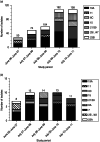Five-year prospective study of paediatric acute otitis media in Rochester, NY: modelling analysis of the risk of pneumococcal colonization in the nasopharynx and infection
- PMID: 24480055
- PMCID: PMC9151263
- DOI: 10.1017/S0950268813003178
Five-year prospective study of paediatric acute otitis media in Rochester, NY: modelling analysis of the risk of pneumococcal colonization in the nasopharynx and infection
Abstract
During a 5-year prospective study of nasopharyngeal (NP) colonization and acute otitis media (AOM) infections in children during the 7-valent pneumococcal conjugate vaccine (PCV) era (July 2006-June 2011) we studied risk factors for NP colonization and AOM. NP samples were collected at ages 6, 9, 12, 15, 18, 24, and 30 months during well-child visits. Additionally, NP and middle ear fluid (MEF) samples were collected at onset of every AOM episode. From 1825 visits (n = 464 children), 5301 NP and 570 MEF samples were collected and analysed for potential otopathogens. Daycare attendance, NP colonization by Moraxella catarrhalis, and siblings aged <5 years increased the risk of Streptococcus pneumoniae NP colonization. NP colonization with S. pneumoniae, M. catarrhalis, or Haemophilus influenzae and a family history of OM increased the risk of AOM. Risk factors that increase the risk of pneumococcal AOM will be important to reassess as we move into a new 13-valent PCV era, especially co-colonization with other potential otopathogens.
Figures
References
-
- Centers for Disease Control and Prevention (CDC). Pneumococcal disease. In: Epidemiology and Prevention of Vaccine-Preventable Diseases: ‘The Pink Book’, 12th edn, 2012, pp. 233–248.
-
- Casselbrant M, Mandel E. Epidemiology. In: Rosenfeld R, Bluestone C, eds. Evidence-Based Otitis Media. Hamilton, Ontario: BC Decker, 2003, pp. 147–162.
-
- Teele DW, Klein JO, Rosner B. Epidemiology of otitis media during the first seven years of life in children in greater Boston: a prospective, cohort study. Journal of Infectious Disease 1989; 160: 83–94. - PubMed
Publication types
MeSH terms
Substances
Grants and funding
LinkOut - more resources
Full Text Sources
Other Literature Sources
Medical
Miscellaneous


